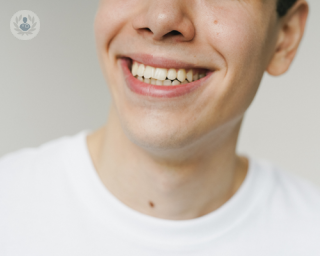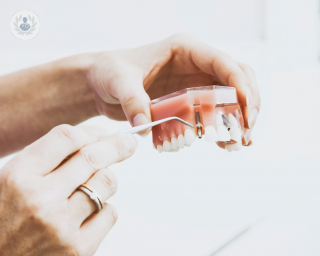What are receding gums?
Receding gums, also known as gingival recession, occur when there is migration of the gum margin, exposing the root of the tooth. This can lead to considerable oral health issues. It is a fairly common oral pathology.

There are four types of gingival recession, according to the Miller's classification:
- Class I: Marginal tissue recession below the mucogingival line.
- Class II: Marginal tissue recession extending to or beyond the mucogingival junction, without periodontal attachment loss (bone or soft tissue) in the interdental space.
- Class III: Marginal tissue recession extending to or beyond the mucogingival junction, with periodontal attachment loss in the interdental space, and dental malposition.
- Class IV: Marginal tissue recession extending to or beyond the mucogingival junction, with severe bone or soft tissue loss in the interdental space, and/or severe dental malposition.
Prognosis of receding gums
You should be aware that the gum does not grow back, so to correct the aesthetic defect and its consequences a gingival graft will be required. Before the graft can be performed the causative factor must first be eliminated.
Symptoms of receding gums
Receding gums can lead to:
- Hypersensitivity to hot and cold
- The development of root caries
- Progressive loss of the gum and bone supporting the tooth which, in some cases, can lead to tooth loss
In the case of anterior (front) teeth, this may be an aesthetic concern.
Medical tests for receding gums
Diagnosis of receding gums is made by observation. You will be able to see it yourself by looking at the typical symptoms of receding gums and if you experience hypersensitivity.
What causes receding gums?
The most frequent causes are:
- periodontal disease (Pyorrhoea)
- aggressive toothbrushing
- dental malposition
- incorrect dental treatment
- mechanical trauma (biting objects, piercings, etc.).
Can receding gums be prevented?
The best way to avoid receding gums is to avoid the factors that cause it, as well as preventing plaque build-up. It is essential to avoid habits such as smoking or overly aggressive brushing and to maintain proper oral hygiene.
If you notice any changes, or possible onset of periodontal disease, see your dentist for an evaluation.
Treatments for receding gums
In the first instance treating receding gums involves tackling the cause. This can involve education on the correct way to brush your teeth, or treatment by a dental hygienist to remove bacteria and tartar around the teeth and inside the gums.
After eliminating the causative factor, surgery to cover the gum may be considered. Periodontal microsurgery techniques can be performed, which consist of covering the gum using your own tissue or a biomaterial known as an acellular dermal matrix.
11-13-2012 05-31-2023Receding gums
What are receding gums?
Receding gums, also known as gingival recession, occur when there is migration of the gum margin, exposing the root of the tooth. This can lead to considerable oral health issues. It is a fairly common oral pathology.

There are four types of gingival recession, according to the Miller's classification:
- Class I: Marginal tissue recession below the mucogingival line.
- Class II: Marginal tissue recession extending to or beyond the mucogingival junction, without periodontal attachment loss (bone or soft tissue) in the interdental space.
- Class III: Marginal tissue recession extending to or beyond the mucogingival junction, with periodontal attachment loss in the interdental space, and dental malposition.
- Class IV: Marginal tissue recession extending to or beyond the mucogingival junction, with severe bone or soft tissue loss in the interdental space, and/or severe dental malposition.
Prognosis of receding gums
You should be aware that the gum does not grow back, so to correct the aesthetic defect and its consequences a gingival graft will be required. Before the graft can be performed the causative factor must first be eliminated.
Symptoms of receding gums
Receding gums can lead to:
- Hypersensitivity to hot and cold
- The development of root caries
- Progressive loss of the gum and bone supporting the tooth which, in some cases, can lead to tooth loss
In the case of anterior (front) teeth, this may be an aesthetic concern.
Medical tests for receding gums
Diagnosis of receding gums is made by observation. You will be able to see it yourself by looking at the typical symptoms of receding gums and if you experience hypersensitivity.
What causes receding gums?
The most frequent causes are:
- periodontal disease (Pyorrhoea)
- aggressive toothbrushing
- dental malposition
- incorrect dental treatment
- mechanical trauma (biting objects, piercings, etc.).
Can receding gums be prevented?
The best way to avoid receding gums is to avoid the factors that cause it, as well as preventing plaque build-up. It is essential to avoid habits such as smoking or overly aggressive brushing and to maintain proper oral hygiene.
If you notice any changes, or possible onset of periodontal disease, see your dentist for an evaluation.
Treatments for receding gums
In the first instance treating receding gums involves tackling the cause. This can involve education on the correct way to brush your teeth, or treatment by a dental hygienist to remove bacteria and tartar around the teeth and inside the gums.
After eliminating the causative factor, surgery to cover the gum may be considered. Periodontal microsurgery techniques can be performed, which consist of covering the gum using your own tissue or a biomaterial known as an acellular dermal matrix.


The causes of receding gums
By Dr Sahil Patel
2025-01-26
Receding gums have a dual impact: on teeth sensitivity as well as aesthetics. Here to offer an expert take on their cause and how they're addressed, is leading London dentist Dr Sahil Patel. See more


Patient advice: how can I make my dental implants last?
By Dr Koray Feran
2025-01-26
At least 10% of dental implants in the UK will have significant problems that will lead to their loss within the first 10 years. Dr Koray Feran, an implant and restorative dental surgeon based in London, explains what a successful and failing dental implant looks like and how you can influence the long-term success of your new teeth. See more


Receding gums: can they be fixed?
By Dr Neesha Patel
2025-01-26
Receding gums refers to a progressive loss of gum tissue, which can lead to tooth root exposure if it isn’t treated. Dr Neesha Patel, a specialist periodontist talks more about receding gums and how they can be treated. See more


Gum graft treatment: what is it and how does it treat receding gums?
By Professor Christian Mehl
2025-01-25
Receding gums, if left untreated, can result in eventual tooth loss and generally occurs as a direct result of poor oral health and hygiene. In our latest article, London-based prosthodontics specialist, Professor Christian Mehl, provides a comprehensive explanation of how receding gums are treated, whilst also outlining the main causes of the unpleasant condition. See more
Experts in Receding gums
-
Dr Sulaman Anwar
DentistryExpert in:
- Gingivitis and periodontitis
- Periodontal Surgery
- Dental implants
- Periodontics
- Receding gums
- Bruxism
-
Dr Crystal Marruganti
DentistryExpert in:
- Periodontitis
- Dental crown
- Receding gums
- Gummy smile
- Periodontal cleaning
- Periodontal Surgery
-
Dr Georgina Rafel Vernet
DentistryExpert in:
- Periodontal cleaning
- Gum graft
- Periodontitis
- Periodontics
- Periodontal Surgery
- Gingivitis
- See all

Serio Dental
Serio Dental
130 Chamberlayne Road, NW10 3JR
No existe teléfono en el centro.
By using the telephone number provided by TOP DOCTORS, you automatically agree to let us use your phone number for statistical and commercial purposes. For further information, read our Privacy Policy
Top Doctors

Forest & Ray - Dentists, Orthodontists, Implant Surgeons
Forest & Ray - Dentists, Orthodontists, Implant Surgeons
8F Gilbert Pl, London, WC1A 2JD
No existe teléfono en el centro.
By using the telephone number provided by TOP DOCTORS, you automatically agree to let us use your phone number for statistical and commercial purposes. For further information, read our Privacy Policy
Top Doctors

TKC - The Kensington Clinic
TKC - The Kensington Clinic
6 Russell Gardens, Kensington
No existe teléfono en el centro.
By using the telephone number provided by TOP DOCTORS, you automatically agree to let us use your phone number for statistical and commercial purposes. For further information, read our Privacy Policy
Top Doctors
-
Serio Dental
130 Chamberlayne Road, NW10 3JR, North LondonExpert in:
- Routine and hygiene care for adults and children
- Dental Implants (replacing teeth)
- Cosmetic dentistry
- Complex restorative dentistry
- Orthodontics
- Periodontics (gum problems)
-
Forest & Ray - Dentists, Orthodontists, Implant Surgeons
8F Gilbert Pl, London, WC1A 2JD, Central LondonExpert in:
- Braces
- Porcelain veneers
- Crowns
- Cosmetic dentistry
- Dental implants
- Orthodontics
-
TKC - The Kensington Clinic
6 Russell Gardens, Kensington, Central LondonExpert in:
- Aesthetic Dentistry
- Dental Implants (replacing teeth)
- Dentistry
- Cosmetic dentistry
- Orthodontics
- Periodontics (gum problems)
- See all
- Most viewed diseases, medical tests, and treatments
- Trigeminal neuralgia
- Snoring
- Chronic headache
- Visual impairment
- Diabetic retinopathy
- Retina
- Visual stress (Meares-Irlen syndrome)
- Presbyopia
- Nystagmus
- Myopia






